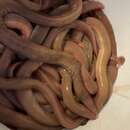Diagnostic Description
provided by Fishbase
Jawless mouth, single nasal aperture, only a single pair of external gill openings, no operculum or covering fold of skin. Grayish or reddish brown above, either plain. Variations in color correspond to the color of the sea bottom.
- Recorder
- Arlene G. Sampang-Reyes
Life Cycle
provided by Fishbase
Copulatory organ absent. The gonads of hagfishes are situated in the peritoneal cavity. The ovary is found in the anterior portion of the gonad, and the testis is found in the posterior part. The animal becomes female if the cranial part of the gonad develops or male if the caudal part undergoes differentiation. If none develops, then the animal becomes sterile. If both anterior and posterior parts develop, then the animal becomes a functional hermaphrodite. However, hermaphroditism being characterised as functional needs to be validated by more reproduction studies (Ref. 51361 ). Probably breed throughout the year in deep water (Ref. 35388).
Trophic Strategy
provided by Fishbase
Found on soft, muddy bottoms; requires high salinity (at least 30 ppt) and low temperature (below 12°C), conditions usually found in deeper waters (Ref. 5951). Feeds chiefly on dead and dying fish of varying species by boring into the body and consuming viscera and musculature. Food includes marine invertebrates such as polychaete worms and crustaceans (shrimp, Pandalus borealis, an important food item) (Ref. 5951), hermit crabs, limpets, nemerteans, priapulid worms and fishes (Ref. 117245). Chiefly nocturnal.
- Recorder
- Drina Sta. Iglesia
Biology
provided by Fishbase
Benthic with reported depths to 782 off Greenland; 960 m in Northwestern Atlantic; and 1,100 m off Norway (Ref. 119696). Found on muddy bottoms where they hide in the mud. Slime is used for defense. Feeds chiefly on dead and dying fish of varying species by boring into the body and consuming viscera and musculature. Chiefly nocturnal. Its eggs are few in number about 19-30 and large (20-25 mm), the horny shell has a cluster of anchor-tipped filaments at each end.
Importance
provided by Fishbase
fisheries: of no interest

